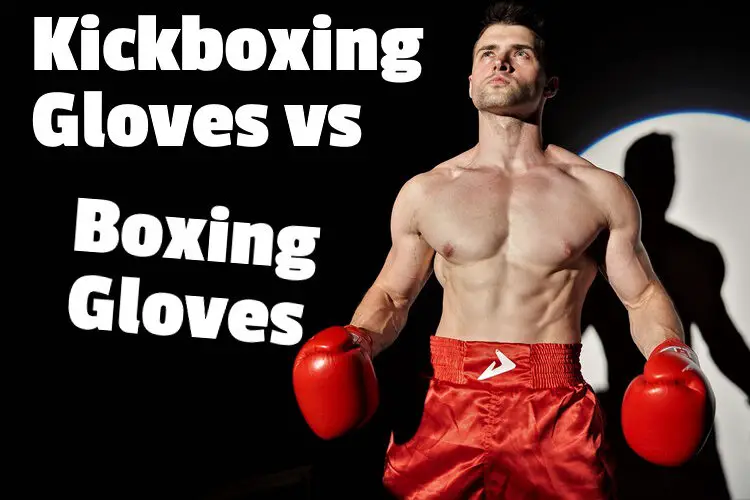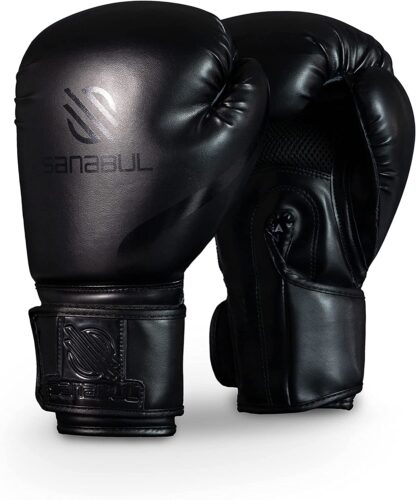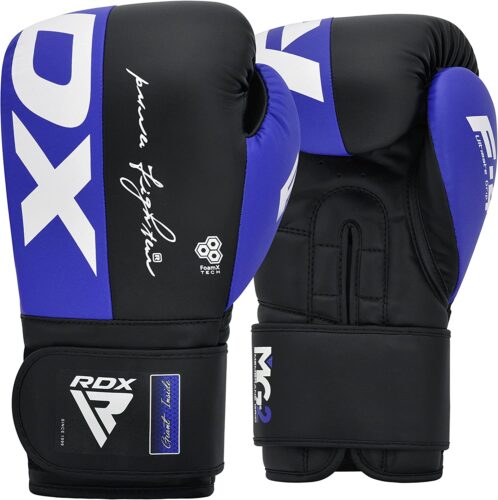When it comes to combat sports such as kickboxing, regular boxing, or other martial sports, almost every type’s gear is different. But if you do more than one type of martial art do you have to buy gear for each? Sparring gloves, in particular, can be very different. So let’s look at kickboxing gloves vs boxing gloves.
Boxing and kickboxing gloves look similar, but generally, kickboxing gloves have the padding distributed more across the entire glove rather than concentrated at the knuckles. Kickboxing gloves also typically have a smaller cuff and are less round making them less aerodynamic.
Deciding which glove is best for your combat sport needs can be a challenge, so it’s important to understand the differences between kickboxing gloves and boxing gloves.
Whether you’re looking for extra padding or wrist protection, there are benefits of using the right glove depending on your sport.
From heavy bag work to Muay Thai fights, understanding what type of glove will provide optimal protection while still giving fighters grip bar control is key.
Learn more about choosing the right pair of boxing or kickboxing gloves and how proper care and maintenance will keep them in great condition over time.
Table of Contents:
- Kickboxing Gloves vs Boxing Gloves: What’s the Difference?
- Are Boxing or Kickboxing Gloves Designed for Heavy Bag Work?
- Choosing the Right Type of Glove for You
- How to Choose the Right Size of Glove
- FAQ
- Conclusion

Kickboxing Gloves vs Boxing Gloves: What’s the Difference?
When it comes to gloves for martial arts and boxing, there are many differences between kickboxing gloves and boxing gloves. But the main difference is the padding, so let’s start with that.
Shape and Padding
Kickboxing gloves are typically larger and more padded than boxing gloves.
They are designed to protect the fighter’s hands and wrists from the impact of kicks, punches, and elbows. The shape of kickboxing gloves is usually less rounded than boxing gloves, with a smaller cuff that wraps around the wrist.
Kickboxing gloves are slightly less aerodynamic too; so punches may not be able to be thrown quite as quickly.
The padding is usually thicker and more evenly distributed throughout the glove, providing better protection for the knuckles and fingers. Boxing gloves, on the other hand, are generally smaller and have less padding than kickboxing gloves.
They are designed to protect the fighter’s hands from punches only, so they have a shorter cuff that does not wrap around the wrist. The padding is usually concentrated in the knuckle area to provide better protection for punches.
The shape of boxing gloves is also more angular than kickboxing gloves, with a tapered design that allows for greater mobility when throwing punches.
Flexibility
Kickboxing gloves and boxing gloves are designed to provide protection for the hands and wrists of the wearer, but they differ in terms of flexibility.
Kickboxing gloves are generally more flexible than boxing gloves, as they are designed to allow for a greater range of motion when striking. The padding on kickboxing gloves is usually thinner than that of boxing gloves, allowing for more flexibility and mobility when throwing punches.
Additionally, kickboxing gloves often have an open palm design which allows for better grip and control when striking. Boxing gloves, on the other hand, are designed with thicker padding to protect the hands from impact and provide more stability when punching.
The padding also limits the range of motion available to the wearer, making them less flexible than kickboxing gloves. Furthermore, boxing gloves typically have a closed-palm design which provides more support but limits dexterity when punching.
In conclusion, kickboxing gloves offer greater flexibility than boxing gloves due to their thinner padding and open-palm design.
My kickboxing gloves are here! Excited for another day of workouts. #FitnessGirl pic.twitter.com/gz86IsRyS4
— Kebramm (@kebramm) July 6, 2022
Thumb area
The thumb area of a boxing glove is designed to be tucked in tight as close to the fist as possible, commonly protected behind the knuckle padding.
This is usually achieved by attaching a strip at the glove to keep it in place or fully attaching it with leather all the way up between the thumb and the hand.
On a kickboxing glove, however, having your thumb a little less ‘tucked in’ to the hand can go a long way and help with grip when catching and clinching.
These gloves usually have a straight thumb, which is directly molded into the actual glove frame.
This allows for more flexibility and movement of the thumb when gripping an opponent or blocking punches. The padding on kickboxing gloves also tends to be thinner than that of boxing gloves, allowing for more dexterity and control when gripping an opponent or blocking punches.
The difference between these two types of gloves is important for fighters to understand so they can choose which type best suits their style of fighting.
Are Boxing or Kickboxing Gloves Designed for Heavy Bag Work?
Boxing gloves are designed primarily for use in the ring, while kickboxing gloves are made specifically for heavy bag work due to their additional cushioning and protection from impact-related injuries.
When hitting a heavy bag with a boxing glove, you risk injuring your hands because they don’t offer enough protection against repeated impacts over time. Conversely, kickboxing gloves provide greater knuckle coverage to permit more powerful strikes without risking harm to the hands or wrists.
Safety should take precedence over all else when it comes to prolonged striking drills, so boxing gloves are not the best choice as they don’t provide enough shock absorption.
Kickboxing mitts and shin guards offer far more protection due to their extra padding.
That makes them a smarter pick for heavy bag work or any other full-contact strikes such as those found in kickboxing fights or Muay Thai bouts.
Put your safety first by investing in gear that will keep you protected during intense workouts.
For the ultimate decision between these two types of fighting equipment, it boils down to personal preference as both lace-up and velcro straps do their job effectively.
Lace-up bag gloves offer more stability but take longer to put on/take off whereas velcro provides quicker access but may not stay snug during an intense session. No matter what you opt for, ensure it meets your expectations to achieve the best outcome.
Kickboxing gloves and boxing gloves are two distinct pieces of equipment with different purposes.
To make an informed decision, one must be aware of the distinctions between kickboxing and boxing gloves. With that being said, it’s time to explore how personal preference and comfort level can play a role in your choice of glove.
Choosing the Right Type of Glove for You
When selecting the right glove for martial arts, it is important to take into account your level of experience and ensure you get a suitable one. For martial arts, the type of glove you select should be contingent upon your skill level as professionals and recreational fighters have varying requirements.
For professional fighters, durability is key.
You’re going to be using your gloves in intense matches where every hit counts, so having a pair of reliable gloves that can take some punishment is essential. Look for ones with extra padding around the knuckles and wrists as well as reinforced stitching along all seams. It’s also important that they fit snugly but comfortably on your hands – no loose ends or gaps.
Casual fighters don’t necessarily need such heavy-duty protection since their fights won’t be quite as intense or frequent. However, comfort should still be top priority here – if the gloves aren’t comfortable then chances are you won’t enjoy wearing them at all.
Look for lightweight materials like leather or synthetic fabrics with breathable linings and adjustable straps for a customized fit.
For the best results, it is recommended to try on different gloves before making a purchase rather than solely relying on reviews from other people.
Don’t just rely on reviews from other people; everyone has different preferences when it comes to comfort levels and style choices so what works great for someone else might not work at all for you.
Hence, it is prudent to go to a nearby sports store (or shop online) and sample various pairs until you discover one that fits perfectly – “test before purchasing” is always an astute guideline when looking for items.
Making a judicious selection of gloves for your sport is essential, as it can profoundly influence how you fare in battle. Considering the importance of selecting an appropriate glove, let us consider some advantages to wearing the right one for your activity.
The right pair of gloves can make a world of difference!
How to Choose the Right Size of Glove
Kickboxing Glove Sizing
When choosing the right size of glove for kickboxing, it is important to consider the size of your hand and the type of glove you are looking for.
Generally, a 16-ounce glove is suitable for heavier sparring and bag work, while a 14-ounce glove is better suited for lighter sparring and pad work. If you are a beginner, it is recommended to start with a 12-ounce glove.
To determine the correct size of glove for your hand, measure from the base of your palm to the tip of your middle finger.
This measurement will give you an idea of what size glove you should purchase. For example, if your measurement is 7 inches or less, then a 12-ounce glove would be suitable; if it’s between 7 and 8 inches, then a 14-ounce glove would be best; and if it’s 8 inches or more, then a 16-ounce glove would be ideal.
It is also important to consider the type of material used in the construction of the gloves.
Leather gloves tend to be more durable than synthetic materials and provide better protection against impacts. Additionally, some gloves come with extra padding on the knuckles or wrist area for added protection during training sessions.
Finally, make sure that you try on several different pairs before making your purchase to ensure that they fit comfortably on your hands. The right size of kickboxing gloves can make all the difference in terms of comfort and performance during training sessions.
Big underdog Trevor Berbick takes the fight to world champ Larry Holmes in #LasVegas in 1981. Berbick surprised many with his showing as he became the 1st of Larry’s title challengers to last the distance. Holmes won by unanimous decision. #Heavyweight #History #Boxing pic.twitter.com/8Do97vCc2I
— Heavyweight History (@HVYWeightHeroes) February 27, 2023
Boxing Glove Sizing
When choosing the right size of boxing gloves, it is important to consider the size of your hands and wrists.
The best way to determine the correct size is to measure your hand circumference. To do this, wrap a measuring tape around your dominant hand just below the knuckles, excluding your thumb.
This measurement should be taken in inches. Generally, a glove size of 12-14 oz is suitable for adults with a hand circumference of 7-8 inches. For those with a hand circumference of 8-9 inches, 14-16 oz gloves are recommended. For those with larger hands, 16-18 oz gloves are ideal.
It is also important to consider the type of boxing you will be doing when selecting glove size.
If you are training for competition or sparring, heavier gloves are recommended as they provide more protection and support for your hands and wrists. If you are training for fitness or recreational boxing, lighter gloves may be more suitable as they allow for greater speed and agility during workouts.
Finally, it is important to ensure that the gloves fit snugly but comfortably on your hands and wrists without being too tight or too loose.
When trying on boxing gloves, make sure that you can make a fist without feeling any discomfort or restriction in movement. If you feel any discomfort when making a fist or if the glove feels too tight or too loose then it is not the right size for you and should be exchanged for another pair that fits better.
For beginners though, the best option is often a slightly oversized glove due to the additional padding.
You don’t want it too big, but bigger gloves can help protect your hands better and allow you to train longer and more often until your hands get used to the boxing training or kickboxing training.
If it’s too painful right out of the gate, you’re more apt to quit before you get going.
Title Gel gloves vs Venum Elite Boxing Gloves? #boxing #kickboxing #muaythai pic.twitter.com/g7p8YuphIS
— asdproshop (@asdproshop) August 1, 2018
Frequently Asked Questions
What oz gloves do kickboxers use?
Kickboxers typically use 10 or 12-oz gloves for training and sparring.
The weight of the gloves provide a balance between protection and dexterity. For competition, fighters will usually wear 8 oz gloves as they provide better hand speed while still providing adequate protection to both competitors.
In some cases, such as Muay Thai competitions, 16 oz gloves are used due to their heavier padding which helps protect against powerful strikes.
How is kickboxing different from boxing?
Kickboxing is a combat sport that combines elements of boxing and martial arts.
It involves striking with fists, elbows, knees, and kicks while standing up. Unlike traditional boxing which only allows punches to be thrown, kickboxing incorporates the use of different body parts as weapons for attacking an opponent. Kickboxers are also trained in defensive maneuvers such as blocking or evading attacks from their opponents.
As a result, it can provide more dynamic self-defense training than regular boxing does.
What is the best boxing glove?
The best boxing gloves on Amazon, meaning the #1 best seller, is the Sanabul Essential Boxing Gloves.
Over 21,000 reviews and most are 5-star so you know these are great gloves! An Amazon’s Choice Product too with multiple color choices and sizes to choose from!
CLICK HERE to see the current price on Amazon. But at last check, they were under $30, so they are a no-brainer!
What is the best kickboxing glove?
The best boxing gloves on Amazon, meaning the #1 best seller, is the RDX Kickboxing Gloves. Over 300 reviews and most are 5-star so you know these are great gloves! Multiple color choices and sizes to choose from!
CLICK HERE to see the current price on Amazon. But at last check, they were under $30, so they are a no-brainer!
Should you use hand wraps for boxing or kickboxing gloves?
Hand wraps are an essential piece of equipment for any boxer or kickboxer.
They provide extra protection to the hands and wrists, as well as helping to keep the gloves in place during a fight. Hand wraps should always be worn under boxing or kickboxing gloves for maximum protection and comfort.
The benefits of using hand wraps include increased support for the wrist and knuckles, improved grip on the gloves, and better shock absorption when punching. Hand wraps also help to reduce the risk of injury when kickboxing by providing additional cushioning between the glove and the skin.
The negatives of using hand wraps are minimal, but they can be uncomfortable if not applied correctly.
It is important to ensure that they are not too tight or too loose, as this can cause discomfort or even injury. Additionally, hand wraps can become dirty quickly if not washed regularly, so it is important to keep them clean and dry after each use.
Overall, hand wraps should always be used under boxing or kickboxing gloves for maximum protection and comfort. The benefits far outweigh any potential negatives, making them an essential piece of equipment for any fighter.
Are velcro boxing or kickboxing gloves just as good as lace-up gloves?
Velcro (hook and loop closure system) boxing and kickboxing gloves are a great alternative to lace-up gloves for those who don’t want to spend the extra time lacing up their gloves.
Velcro gloves are easier to put on and take off, making them ideal for quick workouts.
However, a Velcro strap may not provide the same level of protection as lace-up gloves. Lace-up gloves are designed to fit snugly around the hand and wrist, providing more support and protection than velcro gloves.
Ultimately, it depends on the individual’s preference and needs when deciding which type of glove is best for them. For those who want a quick workout with minimal fuss, velcro boxing or kickboxing gloves may be the way to go.
For those who want more support and protection during their workouts, lace-up gloves may be the better option.
Conclusion
In the end, when selecting between kickboxing and traditional boxing gloves, it ultimately boils down to individual taste and which sport is being practiced.
Both types of gloves offer protection for your hands as well as wrist support while allowing flexibility with different colors and styles available. And avoid using MMA gloves for either boxing or kickboxing due to the differences between them all.
Different sports tend to have different equipment and protective gear for good reason! Remember that no matter what type of glove you choose, having the right one will help keep your fighter’s hands safe.
Image by Valentin Tikhonov from Pixabay
As an Amazon Associate, I may earn a small commission from qualifying purchases if you click on Amazon from my site and choose to make a purchase. You can read my complete affiliate disclosure for more details.



I’ve learned so much from this blog and have implemented many of the tips and advice into my daily routine Thank you for sharing your knowledge!
Thanks so much! I appreciate you being here.
Jeff